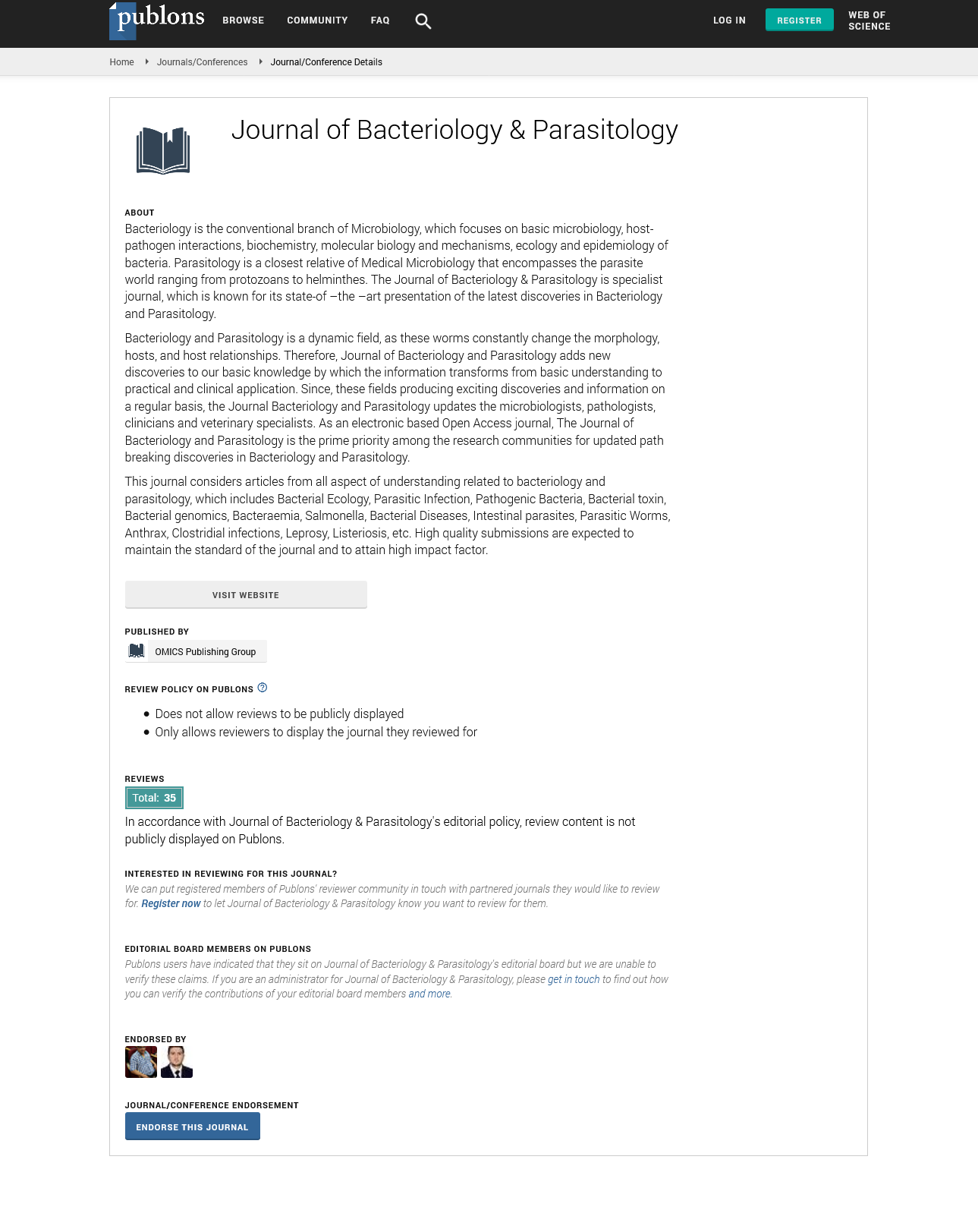Indexed In
- Open J Gate
- Genamics JournalSeek
- Academic Keys
- JournalTOCs
- ResearchBible
- Ulrich's Periodicals Directory
- Access to Global Online Research in Agriculture (AGORA)
- Electronic Journals Library
- RefSeek
- Hamdard University
- EBSCO A-Z
- OCLC- WorldCat
- SWB online catalog
- Virtual Library of Biology (vifabio)
- Publons
- MIAR
- Geneva Foundation for Medical Education and Research
- Euro Pub
- Google Scholar
Useful Links
Share This Page
Journal Flyer

Open Access Journals
- Agri and Aquaculture
- Biochemistry
- Bioinformatics & Systems Biology
- Business & Management
- Chemistry
- Clinical Sciences
- Engineering
- Food & Nutrition
- General Science
- Genetics & Molecular Biology
- Immunology & Microbiology
- Medical Sciences
- Neuroscience & Psychology
- Nursing & Health Care
- Pharmaceutical Sciences
Prevalence of IGRA positivity among household contacts of tuberculosis patients: A perspective from high incidence setting Mongolia
7th International Conference on Bacteriology and Infectious Diseases
June 04-05, 2018 Osaka, Japan
Ulziijargal Gurjav, Munkhzaya Ankhbat, Gantungalag Ganbaatar, Michaela Gilbert, Khulan Batjargal, Batbayar Ochirbat, Delgerekh Baigal, Badamtsetseg Jargalsaikhan, Oyunsuren Munkhjargal, Sunjidmaa Bolormaa, Narankhuu Yansanjav, Narangerel Luvsanyandan, Gantserseg Dorj, Enkhmandakh Danjaad and Ganmaa Davaasambuu
Mongolian National University of Medical Sciences, Mongolia
Mongolian Health Initiative, Mongolia
University of Sydney, Australia
Khan-Uul District Hospital, Mongolia
National Center for Communicable Diseases, Mongolia
Harvard T.H. Chan School of Public Health, USA
Posters & Accepted Abstracts: J Bacteriol Parasitol
Abstract:
Background & Aim: Tuberculosis (TB) incidence rate of Mongolia remains high as the national survey conducted between 20142015 revealed a rate of 75 cases per 100,000 population of which 560 were bacteriologically confirmed TB. The present study investigated the comparison of case finding and latent tuberculosis infection prevalence using the symptom review, Tuberculin Skin Test (TST) and Interferon Gamma Release Assay (IGRA) QuantiFERON-TB Gold Plus (QFT-Plus) as primary screening tools for TB household contacts. Materials & Method: Household contacts of TB patients diagnosed between January 1st and August 31st 2017 were enrolled in the study. Household contacts were defined as either living in the same household or living in a separate household but in a same fenced area. TB patients included pulmonary and all other forms of TB. Household contact demographic data, TST and QFT-Plus results were obtained during the routine preventive screening per manufacturerâ??s instructions. Anyone who was absent during the screening was excluded from the study. Mongolia currently practices universal BCG vaccination at infancy with no repeat dose. TST and IGRA results were compared. QFT-Plus positive results were further analyzed for CD8 T-cell responses as a potential measure of recent infection by subtracting the quantitative values of the TB1 antigen tube from TB2 and using a value of greater than 0.6 IU/ml as a threshold for a significant CD8 response. Results: Of 314 contacts screened, 29 did not consent to blood draw and 5 additional patients lacked TST and therefore 34 patients were excluded from the study. 280 participants completed dual testing and 46.8% (136) and 57.1% (160) were IGRA and TST positive, respectively. Concordance of the both tests was fair (k=0.374, p<0.001) with an agreement rate of 37.1% (104). The rate of a positive IGRA and TST was affected by age with participants >15 years having a greater odds (3.2 vs. 2.2) as compared to <15 years. Among participants <15 years, 15 participants reported a positive TST and a negative IGRA. In participants >15 years, 10 participants reported a positive TST and a negative IGRA. CD8 responses were present in 45.6% (62/130) of QFT-Plus positive participants. Conclusion: The rate of TB infection is high regardless of assay used among household contacts in Mongolia. Although concordance was fair, the prevalence of infection was 18% lower by IGRA compared to the TST. The high CD8 response rate among QFT-positive responders is consistent with other contact studies and may be indicate high rates of recent transmission. This study demonstrates that using the IGRA QFT-Plus can substantially reduce the need for preventive treatment among contacts in Mongolia and having the additional information from the CD8 response may be useful for clinical management. ulziijargal.g@mnums.edu.mn

